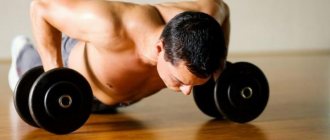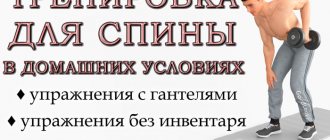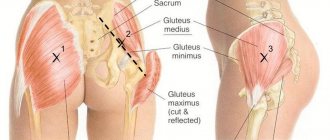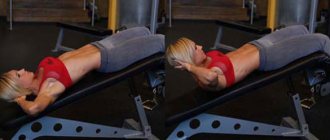Many men and women want their back to have a beautiful shape and their muscles to be toned. But if you do the exercises incorrectly or overload your back and spine, there is a risk of injury. Therefore, it is important to know the specifics of training the latissimus dorsi muscles.
The latissimus muscles are the decoration of the entire torso. They are what make the back powerful and wide. The latissimus dorsi are flat muscles that lie on top of the spinal erectors.
Exercises for the back muscles can be performed both in the gym and at home.
Anatomy of the back muscles
There are several groups of back muscles:
- The lats and trapezius occupy the main part, starting at the spine and then running along the side of the body. They make up the largest volume of muscle mass in the back and they contain the main strength. The trapezius is the dominant muscle group in the upper back.
- The rhomboids, infraspinatus and teres minor muscles run diagonally across the upper back. They are worked out using traction exercises.
- The erector spinal muscle , which is dominant in the lower back, runs vertically along the spine.
Correctly selected exercises allow you to use all the back muscles. A complex lesson includes increasing muscle mass, working the latissimus muscles and training other groups.
Features of back training
Frequent injuries when working out in the gym and at home are injuries to the back and spine.
This is due to non-compliance with safety rules and training features:
- Back training for boys and girls can be combined with tasks for triceps, legs, biceps and shoulders.
- If your work involves a lot of physical activity, trainers advise doing 3-4 sets per workout. If there is no constant load on the back, you can increase the number to 6-8.
- The optimal amount is 2-3 back exercises. If the goal is relief and muscle building, do 10-15 repetitions. If the goal of the workout is to increase strength, 5-7 repetitions will be enough.
- Be careful with the choice of exercises and the number of approaches. Excessive load can cause spinal injury.
- In your first bodybuilding classes, use only light weights. Even if you think you can handle a larger load. In order not to injure your back, you first need to strengthen the muscular-ligamentous apparatus.
Timely treatment
Unfortunately, “broad back syndrome” cannot be treated at all. Over time, everything goes away on its own. There is even an assumption that our distant ancestors also took a pose with their elbows out in order to scare their enemy and look as scary as possible. Or vice versa, to appear more powerful and beautiful for your beloved woman.
Rules for training back muscles
To make the exercises effective, follow simple rules that will increase the effectiveness of the exercises:
- The Big Three Rule. There should be three main exercises in the training cycle: deadlift;
- barbell or dumbbell rows;
- pull-ups.
- start the movement by moving your shoulder back;
What is broad back syndrome
During adolescence, the human body undergoes a restructuring: boys become young men, girls become young women. For some, the changes are easy, while for others, not only the body, but also the psyche changes dramatically. All boys strive to become authoritative individuals, to have influence on their peers, and to enjoy success among older girls.
All this is quite difficult to achieve when a young man is physically unable to fight back the offender and even stand up for himself, not to mention his girlfriends. Accordingly, an additional goal appears - to be a strong, pumped up handsome man. However, the constitution of the body often “puts a spoke in the wheels.” A thin physique and the restructuring of the body do not allow you to gain weight and become a muscleman.
As a result, the young man tries to at least somehow attract attention to himself, to earn the respect of those who are a little luckier with their figure. Widely spaced arms, raised shoulders, a thrown back head, an arrogant look - all this is the imaginary broad back syndrome.
Basic exercises for the back
Thanks to basic exercises, you will master the technical side of training for the back muscles. And you can start doing more complex exercises.
Pull-ups
Exercises with a bar allow you to use the muscles of the back, forearm, and biceps.
- If you want to increase the load on your back, make your grip wider.
- To stretch the muscles in width, you need to try to touch the bar with the back of your head during the exercise.
- Hands should be placed on the bar at a distance slightly wider than shoulders with an overhand grip.
- Start pulling yourself up, trying to touch the bar with your upper chest.
- Hold for 2-3 seconds at the highest point and slowly return to i. P.
Do 10 times, 4 sets.
Deadlift
This exercise is one of the most effective for building strength and strengthening the muscles of the back and spine.
- I.p. - deep squat. The bar should be taken with an overhand grip.
- You should push your hips back, push your heels off the floor, and lift yourself out of the squat. The back muscles should be tense and your posture should be straight.
- Slowly lower your hips down until the barbell touches the floor.
Do 6-12 repetitions of 3-4 sets.
Bent over dumbbell raise
This exercise has a positive effect on the back muscles and oblique abdominal muscles.
- I.p. – the left hand, which is the supporting one, and the knee are placed on the bench.
- You should feel tension in your core, your back should be smooth and straight. Focusing on working your back and biceps muscles, slowly lift the dumbbell to chest level.
- Maintain this position for 1 second. Slowly lower the dumbbell.
Perform 3-4 sets of 10-14 repetitions.
Lifting dumbbells while lying down
The exercise effectively affects the latissimus dorsi and core muscles.
- I.p. – lying down with dumbbells in your hands.
- Focus on tension in the core muscles; your back should be straight. With effort, raise your right arm towards your body. Keep the body static.
- Hold the position for 1 second, then take the position. Repeat the exercise with your left hand.
Perform 10-14 repetitions for 3-4 sets.
Basic exercises for training the lats
Here you will find the best exercises with descriptions and photo demonstrations for high-quality training of the latissimus dorsi muscles.
Published:
Author:
The most important muscles that take part in the formation of the back are the latissimus. They start in the back of the armpits and go down to the waist. It is the latissimus muscles that give the back a powerful cone-shaped appearance, visually increasing the width of the shoulders and narrowing the waist. Therefore, any athlete involved in bodybuilding tries to make great efforts to develop them. This is a real lifesaver for those who have naturally narrow shoulders - well-developed lats can solve this problem.
The latissimus dorsi muscle plays a leading role in many sports (swimming, javelin throwing, rowing, kayaking, cross-country skiing, handball, volleyball, tennis, rock climbing and artistic gymnastics.). Before you start training, we recommend that you familiarize yourself with the anatomy and features of training the latissimus muscles. We wrote about this earlier (link below).
Isolation exercises for the back
The purpose of this complex is to strengthen muscles and is done at the end of the lesson. Thanks to this, those fibers that “rested” during the execution of the main elements are included in the work.
Exercises with weights
Bent over dumbbell lift with one arm
It is aimed at working not only this muscle group, but also the trapezius, biceps and forearm.
- Place a dumbbell in your right hand with a parallel grip. From the bench, stand on your left side with your feet together.
- Stand with your torso parallel to the floor and your back slightly arched at the waist. Straighten your arm with the dumbbells, slightly lowering your shoulder.
- Taking a deep breath, lift the dumbbell as high as possible, feeling the tension in your back and deltoids.
- When your elbow is at shoulder level, lift your shoulder. This promotes increased work of the mid-back and latissimus muscles.
- Hold the dumbbell in this position for 2-3 seconds. As you exhale, lower it down.
Repeat 8-12 times for the right hand. The same number of repetitions for the left. Perform 3-4 approaches.
Lifting the barbell to the waist
The main focus of this exercise is on the psoas and latissimus muscles.
- I.p. – feet shoulder-width apart. Take the barbell with a wide overhand grip.
- Bend your knees and lean forward. The bar hangs freely in outstretched arms. Arch your back a little.
- Raise the barbell to the level of your stomach and lower it.
Do 8-10 lifts in 3-4 sets.
T-Bar Raise
- Place a barbell with weights between your legs. Grasp the bar.
- Bend at an angle of 45º, feeling the tension in the muscles of the core and lower back, while keeping your back straight.
- Pull the bar toward your chest, tensing not only your lats, but also your trapezius muscles. Hold the barbell for 1 second, then slowly lower the barbell.
Do 10 lifts in 3-4 sets.
Pullover lift with dumbbell
- I.p. - lying on a bench. Hold the dumbbell at arm's length above your chest. Press your palms against the top disc.
- Using your back and lower back muscles, lower the dumbbell behind your head so that it is just below the bench.
- Arms should be straight. Raise the dumbbell into a standing position, using the latissimus dorsi muscles.
Do 8-10 lifts for 3-4 sets.
Exercises on simulators
Horizontal pulldown of the lower block from a sitting position
- Perform movements connecting your shoulder blades. Each rep, pull the V-shaped brace toward your waist.
- If you choose a narrow grip option, release the weight for 2-3 counts. Keep your back straight to reduce stress on your lumbar spine.
- This exercise not only makes your back muscles more prominent, but also helps improve your posture.
One-arm horizontal pulldown from a sitting position
In addition to this group of back muscles, stabilizer muscles are actively involved in this exercise.
- The D-shaped handle should be at chest level. Keep your back straight, look straight ahead. Press your feet against the supports with all your might.
- Using a parallel grip, grab the handle with one hand, with the other resting on your thigh. Pull the handle back, moving your elbow behind your back. Make sure your body remains motionless.
- Stay in this position, focusing on tensing the muscles of your back and shoulder. Then return to and. P.
Perform 10-12 repetitions of 3-4 sets.
Wide grip lat pulldown at an angle
The 30º row is a classic exercise for increasing back muscle mass.
- I.p. – sitting on a bench facing the machine. Grasp the handle with an overhand grip, placing your palms slightly wider than shoulder-width apart.
- At an angle of 30º, lean back relative to the vertical line. Tilt your chest slightly forward and keep your shoulders back. Hold this position for a few seconds.
- Start pulling the handle until it touches your chest. The shoulder blades should be retracted. Return to i.p.
Do the exercise 8-10 times for 3-4 approaches.
One-arm horizontal row with added rotation
By adding a rotation element to the exercise, you engage the shoulder stabilizer muscles and improve overall upper back development.
- I.p. – while sitting, place the handle in the shape of the letter D at stomach level. Keep your back straight.
- With your right hand, grab the handle with an overhand grip. Place your left hand on your thigh. Legs should be slightly bent at the knees.
- As you exhale, pull the handle, moving your shoulder blade back. At the same time, rotate the body. Hold this for 1 second, then take an i.p.
Do 8-10 repetitions for 3-4 sets.
Exercises for the trapezius muscle
Exercises with weights
Barbell Shoulder Raise
- I.p. – bend your knees and place them shoulder-width apart. Raise the barbell behind you so that it is at hip level.
- Shoulders should be raised as high as possible, arms should be straightened. Hold the muscles tense for 1 second. Slowly lower the barbell.
Do 12 lifts, 3 sets each.
Front Barbell Shoulder Raise
- I.p. – Place your feet shoulder-width apart. Take the barbell with an overhand grip and lift it in front of you.
- As you exhale, raise your shoulders as high as possible and hold them for a second. After inhaling, return to the first position.
Do 8 lifts, 3 sets each.
Overhead dumbbell power lift
One of the most effective exercises for working this muscle group. Depending on your endurance, you can use heavier weights.
- I.p. – place a dumbbell between your legs. Squat down to pick it up.
- With a sharp push from your hip, quickly rise up and lift the dumbbell above your head.
Repeat the lift 10 times for 3 sets.
Raising the barbell overhead
- This exercise helps increase upper back strength.
- You need to hold the barbell above your head, raising your shoulders and squeezing your trapezius muscles.
- Tighten your muscles for 3 seconds, then gradually relax them.
- Do 10 times, 3 sets.
Exercises on simulators
Lifting the barbell on a Smith machine
This exercise has a positive effect on the muscles of the upper and middle back and shoulders. Place the bar at mid-thigh level. Feet should be shoulder-width apart. Keep your back straight and lift the barbell using an overhand grip.
As you exhale, raise your shoulders to ear level. As you inhale, hold this position for 2-3 seconds, then return to IP. Do the lift 12 times in 3 sets.
Reverse Grip Pec Deck Exercise
This exercise effectively works the middle and lower parts of this muscle group. Fix the seat of the exercise machine at the lowest level. Grasp the handles of the machine with a reverse grip.
Begin to move the handles of the machine back, using the trapezius muscles. Retracting them as much as possible, fix this position for a second. Then gradually take up the position. Do 10 repetitions.
Pulling the block to the side with both hands
- Perform the exercise using only the upper block. Taking its handle, bend your arms and take a supporting stance.
- Pull the handle to the side and back until your arms are straight. Fix the position at the lowest point for a few seconds, while simultaneously straining your pectoral muscles.
- Slowly take the i.p.
Exercise for trapezius using a rope on a machine
To perform this, you need to secure a special rope (rope) in the middle or upper part of the simulator.
- I.p. - standing with your knees bent, grab the rope with both hands. Move away from the simulator at a distance of 1-1.5 meters.
- Pull the rope towards your chin so that it is parallel to the floor. The shoulder blades should be brought together and the elbows should be higher than the shoulders.
- Without sudden movements, return to the standing position.
Perform 15 repetitions of 3 sets.
Training program for muscle growth
Smith Machine Bent Over Row
- 3 sets of 6-8 reps
- Body part: Middle back Equipment: Exercise
Deadlift
- 5 sets of 4-8 reps
- Body part: Quadriceps Equipment: Barbell
Wide grip pull-ups
- 3 sets of 8-12 reps
- Body Part: Lat Equipment: Bodyweight
Pull-down of the upper block behind the head
- 3 sets of 8-12 reps
- Body part: Lat Equipment: Block
Add to Calendar * Add to My Workouts * Print Workout
* — The service is in beta testing
Exercises for the lower back muscles
It is better to leave this group of exercises for the end of the lesson. By strengthening the lumbar muscles, the risk of spinal problems is reduced.
Exercises with weights
Deadlift
This exercise works almost all the muscles in your back and is essential for increasing muscle mass.
- I.p. – standing in front of an empty bar, your legs should be placed slightly narrower than your shoulders, your feet parallel to each other. Keep your back straight and your pelvis pushed back, which creates a natural arch in your lower back. Make sure your back is not round.
- Next, tilt your body slightly forward, pushing your pelvis back. If you did everything correctly, your shoulders will be slightly in front of your shin line. The knees will be slightly bent. The tilt should be made at an angle of 40-45º.
- Squat down to grab the bar with your palms facing you. Make sure your body remains motionless. The shoulders should move along a vertical axis.
- Slowly straighten your legs, and only then straighten your back. When you stand up straight, your shoulder blades should be squeezed together.
- Then start lowering the bar. First, bend your back 40-45º, then your legs.
Do 10-15 repetitions for 3-4 sets.
Deadlift
Before you begin this exercise, make sure you have a good stretch in your lower back and back of your thighs. The main technical points of this exercise are the same as in a regular deadlift.
- I.p. – standing, feet shoulder-width apart, toes under the barbell.
- Do a squat and grab the barbell with the following grip: one hand on top, the other on bottom. The grip should be shoulder width apart.
- The back should be straight. When the bar is above your knees, sharply straighten your legs. Make sure your chest and shoulders are back. Maintain a stable position.
Perform 10-12 repetitions of 3-4 sets.
Sumo deadlift
This deadlift is similar to the classic version, but there are important differences. One of them is that leg stretching is important for this exercise. Also, the feet need to be turned 45º degrees, and the legs should be set quite wide.
- Place your feet wider than your shoulders. Consider your height: the taller you are, the wider your feet should be. The lower back should have a natural arch due to the pelvis moving back. Keep your head straight.
- Do a deep squat with your body slightly bent. Take the bar with a close grip.
- You must lift the barbell using your leg muscles. When your legs are completely straight, straighten your body and squeeze your shoulder blades together.
- There should be no breaks between the work of the legs and lower back; all movements are smooth and measured.
Do 15-20 repetitions for 3-4 sets. Gradually increase the weight.
Forward bends using a barbell
This exercise is the most effective for training the lower back:
- Feet shoulder width apart. Take a barbell with a wide grip, place it on your trapezius and stand straight.
- I.p. – stand up straight, bend your back slightly at the lower back. The lower back muscles should be tense, and your legs should be slightly bent at the knees.
- While inhaling deeply, slowly lean forward while moving your pelvis back.
- When the body is parallel to the floor, take the position.
Perform 10-12 inclines in 3-4 sets.
We do not progress the load in exercises
For those who are not in the know, progression of loads is used in all speed-strength sports. IN ALL! Because We are discussing bodybuilding, without progression of loads - muscle growth is, in principle, impossible. When you understand this, your back (and more) will begin to grow.
Some people (losers) have been working with the same working weights for years... so they pressed that damn bench press of 80 kilograms, and they still do it six months or a year later. THE LOAD DOES NOT CHANGE FOR HALF A YEAR TO A YEAR! AT ALL. So why the hell did your muscles change? The load is constant and the same. Isn't that so hard to understand?
You can progress the load in different ways:
- Increasing weights from workout to workout
- Increase reps
- Increasing the number of approaches to exercises
- Reducing rest between sets (approaches)
Beginners (and even advanced ones) can progress by adhering to at least 1 method (i.e., increase the weight in the exercises, from workout to workout).
But, I combine the 1st and 2nd methods into one (in my opinion, this is the most effective/convenient/as you wish), i.e. I combine progression in the form of increasing weights + increasing repetitions from workout to workout. Which I highly recommend to you too!
Correctly, if a person does not use progression in his training, he produces the usual amount of hormones, which is not sufficient to trigger protein synthesis in the cell. And if he used progression, then he would have STRESS at each workout (in the form of progression - increasing working weights/repetitions, because he took heavier weight than in the previous workout / he did a little more repetitions than in the previous workout, which subsequently force the muscles to adapt to this progression, and therefore grow).
We don’t do the exercises correctly
Here one of two or two at once. Either you are completely incorrectly performing this or that exercise for the back muscles, or you are performing the exercise more or less correctly, but you are working mainly with the BICEPS (and not with your back, as needed), as a result of which the biceps steals most of the load, preventing you from realizing your back. Or you have both =)
I have already repeatedly stated that without the correct technique, all your efforts in the gym or at home (depending on where you train) are aimed only at your ass, damn it.
If you do not learn to perform this or that exercise CORRECTLY (IDEAL), you can forget about muscle growth (in our case, the growth of back muscles). Moreover, you need to learn how to perform the exercise in such a way that when doing it, only your BACK MUSCLES work, without the BICEPS (well, at a minimum, because it’s probably even impossible to turn it off completely) which steal the load from your back, thereby preventing them from growing.
Ps I also had this problem. I couldn’t learn to (feel) my back, all the load was stolen by my biceps, my back kept growing and growing, in general, it was a nightmare. And what do you think?... I had to retrain myself. I threw out pull-ups on the horizontal bar altogether, instead put in pull-downs to the chest, and started working with small weights, slowly under control, carefully, trying to feel my back, concentrated (I thought about the back muscles, consciously turned off the bitsuha and over time, I got better and better and better).
Yes, of course, it was damn difficult (especially psychologically, working with small weights, when you can work with large ones, and seem worse to others than you really are), but these are necessary measures (because in the beginning I did not learn how to do All the exercises are done “as they should”, and here is the payback.).
COMBO (reasons No. 1 and No. 2 are very often INTERRELATED).
Also one of my previous mistakes. And apparently, a huge number of people fall for it... The trick is that people, in pursuit of weight (load progression), violate the technique of performing this or that exercise. This in turn is unacceptable!
It is ABSOLUTELY NECESSARY to progress the load (increase the weights on the apparatus) (because without this there will be no muscle growth), but this should not be done using USE TECHNIQUE. Otherwise the meaning is lost. Do you understand? Technology comes first. If you progress the load, but do the exercises through the butt, then the result will be the same.
Lack of mental brain-muscle connection (neuromuscular connection)
A little higher (in this article) we talked about the technique of performing exercises. Remember? =)
So, the neuromuscular connection is very closely intertwined with that reason, because if you have the correct (well, let’s say, ideal) technique for performing this or that exercise, it will be much easier for your brain to contract the muscles you need (in our case, the back muscles).
Exercises for the lower back on the machine
Hyperextension
Hyperextensions are suitable for beginners and those with weak backs. This exercise does not overload the spine and joints and maintains muscle tone.
- I.p. – lying on the machine on your stomach, secure your heels under a special cushion.
- Bend down and slowly rise until your body resembles a straight line. Stay in this position for 2-3 seconds. Make sure that there is no strong arching in the lower back. Return to i.p.
Do 10-12 repetitions for 3-4 sets.
Reverse grip barbell row on the Smith machine
Thanks to this grip, the biceps work more actively and the lower back muscles receive more load. You should tilt at about a 45º angle, using your legs and hips a little when lifting heavy weights. Do 8-10 repetitions for 3-4 sets.
One-arm barbell row using a Smith machine
- I.p. – standing sideways to the exercise machine. Grip the bar in the center, one leg slightly behind, knees bent.
- Try to pull the bar as high as possible.
Do 8-10 repetitions for 3-4 sets.
It is not at all necessary to include all of the listed exercises in your workout. It will be enough to do 2-3 exercises to pump up the muscles, but in a high-quality manner. And then you will have a sculpted back, and your muscles will be strengthened.
Alexandrova Anastasia
Nutrition and healthy lifestyle specialist and author of myfitnesblog.com. For many years, she has successfully helped women and men lose weight and maintain a beautiful figure.











